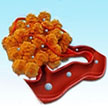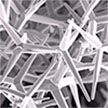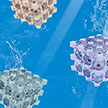Showing Spotlights 337 - 344 of 2779 in category All (newest first):
 The diversity, complexity, and heterogeneity of malignant tumor seriously undermine the efficiency of mono-modal treatment. Recently, multi-modal therapeutics with enhanced antitumor efficiencies have attracted increasing attention. However, designing a nanotherapeutic platform with uniform morphology in nanoscale that integrates with efficient chem-/sono-/photo-trimodal tumor therapies is still a great challenge. Reseaerchers now designed a nanotherapeutic platform with uniform morphology in nanoscale that integrates with efficient chem-/sono-/photo-trimodal tumor therapies.
The diversity, complexity, and heterogeneity of malignant tumor seriously undermine the efficiency of mono-modal treatment. Recently, multi-modal therapeutics with enhanced antitumor efficiencies have attracted increasing attention. However, designing a nanotherapeutic platform with uniform morphology in nanoscale that integrates with efficient chem-/sono-/photo-trimodal tumor therapies is still a great challenge. Reseaerchers now designed a nanotherapeutic platform with uniform morphology in nanoscale that integrates with efficient chem-/sono-/photo-trimodal tumor therapies.
Oct 29th, 2021
 Scanning probe lithography techniques rely on the use of cantilevers to pattern sub-100 nm structures generated by the mechanical contact between a cantilever tip and a surface. SPL, with its high resolution, is a popular method for prototyping nanoscale structures. Overcoming the current limitations of SPL - the lack of high-resolution, high-speed throughput at low cost - researchers developed a new technique they termed nanocalligraphy scanning probe lithography.
Scanning probe lithography techniques rely on the use of cantilevers to pattern sub-100 nm structures generated by the mechanical contact between a cantilever tip and a surface. SPL, with its high resolution, is a popular method for prototyping nanoscale structures. Overcoming the current limitations of SPL - the lack of high-resolution, high-speed throughput at low cost - researchers developed a new technique they termed nanocalligraphy scanning probe lithography.
Oct 28th, 2021
 Researchers demonstrated that two dissimilar materials - molecular energetic materials and ferroelectrics - can be combined to obtain a chemically driven electrical energy source with high-power density. They obtained chemically driven electrical energy with a high specific power of 1.8 kW/kg and achieve an estimated detonation velocity comparable to trinitrotoluene (TNT) and hexanitrostilbene (HNS). Such a power source could potentially be employed for on-demand energy sources, propulsion, or thermal batteries.
Researchers demonstrated that two dissimilar materials - molecular energetic materials and ferroelectrics - can be combined to obtain a chemically driven electrical energy source with high-power density. They obtained chemically driven electrical energy with a high specific power of 1.8 kW/kg and achieve an estimated detonation velocity comparable to trinitrotoluene (TNT) and hexanitrostilbene (HNS). Such a power source could potentially be employed for on-demand energy sources, propulsion, or thermal batteries.
Oct 14th, 2021
 Researchers have developed an antiviral dressing material with visible-light-activated sterilizing properties that enables physical and chemical protection against viral agents like Herpes simplex. They re-engineered a common additive agent found in sunscreen (zinc oxide) to be self-sterilizing within a non-woven fibrous mats for herpes virus treatment. The self-sterilizing function creates a 'green' associated oxidant hydrogen peroxide (hydrogen peroxide), capable of eliminating harmful bacteria and viruses.
Researchers have developed an antiviral dressing material with visible-light-activated sterilizing properties that enables physical and chemical protection against viral agents like Herpes simplex. They re-engineered a common additive agent found in sunscreen (zinc oxide) to be self-sterilizing within a non-woven fibrous mats for herpes virus treatment. The self-sterilizing function creates a 'green' associated oxidant hydrogen peroxide (hydrogen peroxide), capable of eliminating harmful bacteria and viruses.
Oct 12th, 2021
 An interdisciplinary approach that integrates optics, bioengineering, and nanotechnology has led to the fabrication of a living optical hydrogel fiber with many applications, including cancer models, physical force sensing, and covid detection, among others. This work represents a simple and low-cost approach to fabricating optical fibers made from biological materials. These fibers can be easily modified for specific applications and don't require sophisticated equipment to generate relevant information. This method could be used for many practical sensing and biological modeling applications.
An interdisciplinary approach that integrates optics, bioengineering, and nanotechnology has led to the fabrication of a living optical hydrogel fiber with many applications, including cancer models, physical force sensing, and covid detection, among others. This work represents a simple and low-cost approach to fabricating optical fibers made from biological materials. These fibers can be easily modified for specific applications and don't require sophisticated equipment to generate relevant information. This method could be used for many practical sensing and biological modeling applications.
Oct 11th, 2021
 Polymer dielectrics are widely used as an insulating material in advanced electronics and electric power systems that require operation at high temperatures and high breakdown conditions. The miniaturization and higher power of modern electronics generate lots of heat, which needs to be dissipated quickly to avoid device malfunction or breakdown. This increased heat also leads to the temperature rise of insulating materials, which gradually causes the loss of dielectric performance. To address this, researchers report a new strategy to achieve high thermal conductive electric insulator polyethylene with high dielectric constant and strength.
Polymer dielectrics are widely used as an insulating material in advanced electronics and electric power systems that require operation at high temperatures and high breakdown conditions. The miniaturization and higher power of modern electronics generate lots of heat, which needs to be dissipated quickly to avoid device malfunction or breakdown. This increased heat also leads to the temperature rise of insulating materials, which gradually causes the loss of dielectric performance. To address this, researchers report a new strategy to achieve high thermal conductive electric insulator polyethylene with high dielectric constant and strength.
Sep 30th, 2021
 Precise patterning of 2D materials is a route to computation and storage using 2D materials, which can deliver potentially better performance and much lower power consumption compared to the technology of today. Researchers now demonstrate an etching process that makes it possible to downsize nanostructures to the 10-20 nm range and obtain smooth edges, sharp corners, and feature sizes significantly below the resolution limit of electron beam lithography. The nanostructured 2D materials can be used themselves or as etch masks to pattern other nanomaterials.
Precise patterning of 2D materials is a route to computation and storage using 2D materials, which can deliver potentially better performance and much lower power consumption compared to the technology of today. Researchers now demonstrate an etching process that makes it possible to downsize nanostructures to the 10-20 nm range and obtain smooth edges, sharp corners, and feature sizes significantly below the resolution limit of electron beam lithography. The nanostructured 2D materials can be used themselves or as etch masks to pattern other nanomaterials.
Sep 4th, 2021
 Hydrogels are fascinating natural or synthetic polymer materials that exhibit very versatile chemistries and physical or biological properties. They are 3D networks of either physically or chemically crosslinked polymers that resemble organic tissues and that can hold large amounts of water within their interlocked molecular network. These soft, translucent materials swell or shrink in response to water absorption or desorption and can hold a large amount of water without losing their structural integrity.
Hydrogels are fascinating natural or synthetic polymer materials that exhibit very versatile chemistries and physical or biological properties. They are 3D networks of either physically or chemically crosslinked polymers that resemble organic tissues and that can hold large amounts of water within their interlocked molecular network. These soft, translucent materials swell or shrink in response to water absorption or desorption and can hold a large amount of water without losing their structural integrity.
Aug 30th, 2021
 The diversity, complexity, and heterogeneity of malignant tumor seriously undermine the efficiency of mono-modal treatment. Recently, multi-modal therapeutics with enhanced antitumor efficiencies have attracted increasing attention. However, designing a nanotherapeutic platform with uniform morphology in nanoscale that integrates with efficient chem-/sono-/photo-trimodal tumor therapies is still a great challenge. Reseaerchers now designed a nanotherapeutic platform with uniform morphology in nanoscale that integrates with efficient chem-/sono-/photo-trimodal tumor therapies.
The diversity, complexity, and heterogeneity of malignant tumor seriously undermine the efficiency of mono-modal treatment. Recently, multi-modal therapeutics with enhanced antitumor efficiencies have attracted increasing attention. However, designing a nanotherapeutic platform with uniform morphology in nanoscale that integrates with efficient chem-/sono-/photo-trimodal tumor therapies is still a great challenge. Reseaerchers now designed a nanotherapeutic platform with uniform morphology in nanoscale that integrates with efficient chem-/sono-/photo-trimodal tumor therapies.
 Subscribe to our Nanotechnology Spotlight feed
Subscribe to our Nanotechnology Spotlight feed





